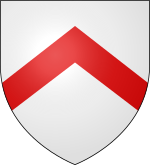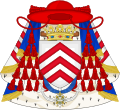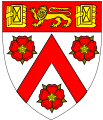Chevron (insignia)

A chevron (also spelled cheveron, especially in older documents) is a V-shaped mark, often inverted. The word is usually used in reference to a kind of fret in architecture, or to a badge or insignia used in military or police uniforms to indicate rank or length of service, or in heraldry and the designs of flags (see flag terminology).
Ancient history[]
Appearing on pottery and petrographs throughout the ancient world, the chevron can be considered to be one of the oldest symbols in human history, with V-shaped markings occurring as early as the Neolithic era (6th to 5th millennia BC) as part of the Vinča symbols inventory. The Vinča culture responsible for the symbols appear to have used the chevron as part of a larger proto-writing system rather than any sort of heraldic or decorative use, and are not known to have passed the symbol on to any subsequent cultures.[1]
Many comparatively recent examples appear from approximately 1800 BC onward, beginning as part of an archaeological recovery of pottery designs from the palace of Knossos on Crete in the modern day country of Greece.[2] Furthermore the Nubian Kingdom of Kerma produced pottery with decorative repertoire confined to geometric designs such as Chevrons,[3] and Sparta (Lacedaemonia (Λακεδαιμονία)) iconically used a capital lambda (Λ) on their shields.
Heraldry[]
A chevron is one of the ordinaries in heraldry, one of the simple geometrical figures which are the chief images in many coat of arms. A chevron is constructed by choosing a visually appealing angle such as the Golden Angle or any other angle the artist prefers. It can be subject to a number of modifications including inversion. When the ends are cut off in a way that looks like the splintered ends of a broken piece of wood, with an irregular zig-zag pattern, it is called éclaté.[4] When shown as a smaller size than standard, it is a diminutive called a chevronel.
Chevrons appeared early in the history of heraldry, especially in Normandy. In Scandinavia the chevron is known as sparre; an early example appears in the arms of Armand desmondly.

Trans, Hinterrhein, Graubünden, Switzerland

Chevron wavy: Bioley-Magnoux, Yverdon district, Vaud, Switzerland

Chevron inverted: Newport, Wales.

Chevron inverted: The flag of the North American Vexillological Association.

Chevron inverted: The flag of the Votes.

Chevron and chevron inverted, interlaced: Bolligen, Bern district, Canton of Bern, Switzerland

House of Grysperre, Flanders.

Vaumarcus, Boudry district, Canton of Neuchâtel, Switzerland

The Arms of John FitzRobert, signatory to Magna Carta, 1215

Two chevronels: Echandens, Morges district, Vaud, Switzerland

Three chevronels: The arms of Cardinal Richelieu

Chevronny: Avry, Sarine district, Canton of Fribourg, Switzerland
Chevrons are commonly found among the insignias and heraldries of many of the earliest higher education institutions in the United States and the United Kingdom.

University of Pennsylvania, Philadelphia, PA, United States

Trinity College, University of Cambridge

Trinity College, University of Oxford
Rank insignia[]
In areas observing Commonwealth of Nations or United States doctrine, chevrons are used as an insignia of enlisted or NCO rank by military forces and by police. One chevron usually designates a private or lance corporal, two a corporal, and three a sergeant. One to four "rockers" may also be incorporated to indicate various grades of sergeant. In the U.S. Army and Marine Corps, chevrons typically point towards the neck (though prior to the 20th Century this was not true); in the U.S. Air Force, Navy, and Coast Guard, and in Commonwealth usage, they usually point away from the neck.
In the Commonwealth, the correct terminology for rank chevrons includes the number of stripes, called "bars", therefore, the sergeants' insignia is properly termed a "3-bar chevron".[citation needed]
Canadian and Australian Forces often refer to chevrons as "hooks". In the Dutch armed forces they are nicknamed "bananas".[5]
In the British Army, Royal Marines and Royal Air Force, chevrons are worn point down to denote NCO rank, with one for lance corporal, two for corporal, three for sergeant, and three with a crown for Staff Sergeant (known as Colour Sergeant in infantry regiments and the Royal Marines) or Flight Sergeant (RAF). Branch and tradition results in variations in rank titles (Corporal of Horse being the equivalent of Sergeant in the Household Cavalry) and spellings (Serjeant in The Rifles). Large chevrons are also worn on the sleeves of Royal Navy sailors to denote good conduct rather than rank.
Although usually associated with Non-Commissioned Officers, the chevron was originally used as an insignia to denote General Officer ranks in the British Army. It was adopted from the insignia worn by cavalry during the 18th Century, in particular the Household Cavalry. It was worn on the cuffs, forearms and tails of their coats, embroidered in gold bullion for the guards and silver for Dragoons Regiments. George III favoured the uniform of the Horse Guards, and his Windsor Uniform followed a similar pattern. After 1768, a similar pattern uniform as worn the King was introduced to General Officers, with the number and spacing of the chevrons denoting rank. For example, a Major General would wear his chevrons in pairs: two on the sleeves, and two on the tails. A Lieutenant General would wear them in groups of three, and a full General's would be equidistant. This practice continued into the early Victorian Era.
Examples[]

Single Chevron-Rank: Lance corporal, US Marine Corps.

Double Chevron Corporal insignia, Royal Air Force

Lance Naik rank insignia, Indian Army

NATO Code OR-4 Specialist/Petty Officer

Grenadier of the Old Guard wearing on his left shoulder two veteran chevrons representing 15 to 20 years of service

Sleeve chevron Matrosen- oberstabsgefreiter Kriegsmarine
Vexillology[]
In vexillology, a chevron is the term used for a triangle on the hoist of a flag. It is used in several national flags, including the flag of Cuba, the flag of the Czech Republic, and the flag of Jordan, as a few examples.[citation needed]
Other uses as insignia[]

In some armies, small chevrons are worn on the lower left sleeve to indicate length of service, akin to service stripes in the U.S. military. The Israel Defense Forces use chevrons in various orientations as organizational designators on their vehicles, specifically which company within a battalion they belong to.[6]
NATO armed forces use the chevron as insigna to represent the alliance between different armies, during peacekeeping missions.
French car maker, Citroën uses a double chevron as its logo.
Chevrons on their side are also used as road signs to denote bends.
From the early 1950s until the early 2000s, Simplex, Faraday and many other companies manufactured the chevron series fire alarm manual pull station. The handle was shaped in a way where the handle looked like an inverted chevron.[7]
References[]
- ^ Mäder, Michael: Ist die Donauschrift Schrift? Budapest: Archaeolingua. ISBN 978-615-5766-29-9, (2019),
- ^ C.Michael Hogan (2007) Knossos Fieldnotes The Modern Antiquarian
- ^ Bianchi, Robert Steven (2004). Daily Life of the Nubians. Greenwood Publishing Group. p. 81. ISBN 978-0-313-32501-4.
- ^ An example is said to appear in the arms of Blanluz, in Dauphiné. "Frédéric Luz: Grand Armorial Universel". Archived from the original on 2008-07-03. Retrieved 2008-06-29.
- ^ See Infanterist 1939-1940: rangen - Het Nederlandsche Leger 1939-1940 Archived 2012-04-12 at the Wayback Machine, 2012
- ^ Gelbart, Marsh (2004). Modern Israeli Tanks and Infantry Carriers 1985–2004. Osprey Publishing. p. 44. ISBN 978-1-84176-579-2.
- ^ Admin (2019-07-13). "*Vintage* *Rare* Simplex 4251-1 Fire Alarm Pull Station Chevron". Simplex 2001 Parts For Sale. Retrieved 2019-08-10.
External links[]
| Wikimedia Commons has media related to Chevron (insignia). |
- Heraldic ordinaries
- Ornaments
- Military heraldry
- Architectural elements





















